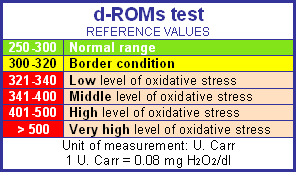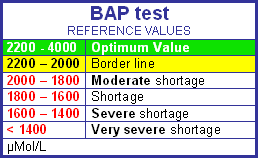Today, thanks to the FRAS 4 technology, oxidative stress levels can be globally assessed by means of two highly innovative tests which are able to provide a precise and reliable information not only about the "aggressors" (free radicals, as measured by d-ROMs test) but also about our "defense" system (plasma antioxidant power, as measured by BAP test).
The opportunity for carrying out one or both the tests is dependent on the aim of analysis and, ultimately, by the type of the patient. In regard to this subject, three categories of individuals can be distinguished: healthy peoples, patients with oxidative stress-related diseases, and patients undergoing treatments able to impair oxidative balance.
 The aim of global assessment for apparently healthy subjects is to identify an eventual disregarded condition of oxidative stress so that its unwanted consequences (i. e. early ageing, diseases, etc.) can be prevented. If such subjects are not exposed to specific factors able to increase the production of free radicals, it is generally sufficient to carry out d-ROMs test only. Indeed, all healthy peoples periodically should undergo this test, since there does not exist an individual without the risk for an exaggerate production of free radicals. Unfortunately, against one's will, all humans are invariably exposed to sun rays, pollutants, pesticides, bacteria etc.
The aim of global assessment for apparently healthy subjects is to identify an eventual disregarded condition of oxidative stress so that its unwanted consequences (i. e. early ageing, diseases, etc.) can be prevented. If such subjects are not exposed to specific factors able to increase the production of free radicals, it is generally sufficient to carry out d-ROMs test only. Indeed, all healthy peoples periodically should undergo this test, since there does not exist an individual without the risk for an exaggerate production of free radicals. Unfortunately, against one's will, all humans are invariably exposed to sun rays, pollutants, pesticides, bacteria etc.
If the apparently healthy subjects, compared to the above depicted individuals, are more continuously exposed to known risk factors for oxidative stress (e. g. incorrect life-style, professional environment, etc.) a distinction must be made. Indeed, if such factors are prevalently able to increase free radicals generation (e. g. strenuous exercise without adequate training, overweight, cigarette smoke, exaggerate alcohol consumption, etc.), it is generally sufficient to perform d-ROMs test only, as a "screening test".
On the contrary, if risk factors in the considered healthy peoples are able prevalently to reduce antioxidant defenses (e. g. sedentary life, incorrect feeding, reduced absorption of antioxidant due to diseases of the bowel, exaggerate consumption of antioxidant compared to the introduced quantity, etc.) both tests should be carried out.
 For all the patients having an ascertained diagnosis of oxidative stress-related disease (e. g. Alzheimer's disease, stroke, infarction, etc.) both tests should be carried out in order: i) to monitor oxidative stress and to prevent its consequences; ii) to monitor the effectiveness of specific therapy on the current disease; and, eventually, iii) to monitor the efficacy of combined treatment (specific treatment plus antioxidant) on oxidative stress which is associated to the current disease. Indeed, in all above mentioned diseases, which often are chronic conditions, oxidative stress tends to assume the feature of an additional health risk factor so that it should be controlled in order to optimize the results of therapy.
For all the patients having an ascertained diagnosis of oxidative stress-related disease (e. g. Alzheimer's disease, stroke, infarction, etc.) both tests should be carried out in order: i) to monitor oxidative stress and to prevent its consequences; ii) to monitor the effectiveness of specific therapy on the current disease; and, eventually, iii) to monitor the efficacy of combined treatment (specific treatment plus antioxidant) on oxidative stress which is associated to the current disease. Indeed, in all above mentioned diseases, which often are chronic conditions, oxidative stress tends to assume the feature of an additional health risk factor so that it should be controlled in order to optimize the results of therapy.
In other words, the evidence of an oxidative stress condition by means of FRAS 4 analysis is an index of incomplete control of the disease. According to these findings, clinicians should be able to program a new therapeutic approach where traditional surgical and/or pharmacological interventions should be integrated with adequate counseling (in order to ameliorate life-style) and, eventually, with antioxidants (which effectiveness can be monitored opportunely with BAP test).
Finally, for all the patients who undergo either pharmacological (e. g. antiblastic chemotherapy, pill, etc.) or surgical (e. g. grafting, by-pass, etc.) intervention, including dialysis, if such treatments are able to impair oxidative balance, both the tests should be carried out, in order: i) to identify and to prevent oxidative stress and its consequences and ii) to monitor the efficacy of eventual antioxidant strategies.